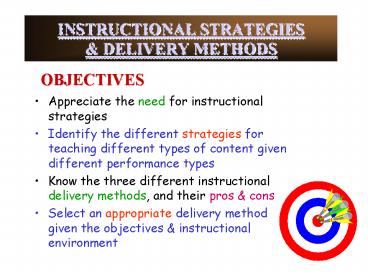INSTRUCTIONAL STRATEGIES - PowerPoint PPT Presentation
1 / 24
Title:
INSTRUCTIONAL STRATEGIES
Description:
Motion. 2. Generative strategy. A. Recall performance. B. Application performance ... Examples: Discussion, Panel Discussion, Case Study, Role playing and Simulation ... – PowerPoint PPT presentation
Number of Views:31
Avg rating:3.0/5.0
Title: INSTRUCTIONAL STRATEGIES
1
INSTRUCTIONAL STRATEGIES DELIVERY METHODS
OBJECTIVES
- Appreciate the need for instructional strategies
- Identify the different strategies for teaching
different types of content given different
performance types - Know the three different instructional delivery
methods, and their pros cons - Select an appropriate delivery method given the
objectives instructional environment
2
Well be answering some of these questions
together.
- What is the best way to teach a fact, concept,
procedure, or attitude? - How can we make the instruction meaningful?
- What is the best way to present the content so
that each learner will master the objectives?
3
.and these as well.
- Is a lecture, self-paced learning, or group
discussion the best method to accomplish the
given objectives? - Which method of self-paced learning would be
appropriate for this topic?
4
WHY INSTRUCTIONAL STRATEGIES?
- Primary Goal To design effective efficient
instruction to produce reliable results each time
it is presented to the learner
(i.e. How do I present the content needed to
achieve this objective? )
5
WHY INSTRUCTIONAL STRATEGIES?
- A well-designed instructional strategy prompts or
motivates the learner actively to make
connections between what the learner already
knows and the new information
(Jonassen Wittrock s generative learning ?
learners deeper understanding longer
retention)
6
WHY INSTRUCTIONAL STRATEGIES?
Jonassen (1988) identifies four different
information-processing strategies for promoting
deeper processing
- Recall
- Integration
- Organisational
- Elaboration
7
INFORMATION-PROCESSING STRATEGIES
- Recall
? helpful for learning facts lists
? learning strategies repetition,
rehearsal (e.g. mental practice), review,
mnemonics
- Integration
? useful for transforming information into
more easily remembered form
? learning strategies paraphrasing
generating questions or examples from the
new information
8
INFORMATION-PROCESSING STRATEGIES
- Organisational
? helps learners identify how new ideas
relate to existing ideas
? learning strategies analysing key ideas
(i.e. identify key ideas interrelate them)
- Elaboration
? learners add their ideas to the new information
? learning strategies generation of mental
images, physical diagrams, sentence
elaborations
9
Prescriptions for Teaching Facts
Initial Presentation
Generative Strategy
Concrete Facts
Rehearsal-practice
? provide learner with experience with the
objects of the fact
? covertly rehearsing
? overtly practising
Develop Mnemonics
? generated by learner
Abstract Facts
? find a concrete representation of the fact
? provide directions on the use of mnemonics
10
Prescriptions for Teaching Concepts
Initial Presentation
? include the best example that illustrates the
category
? present additional examples to refine the
category further, follow by non-examples
? use models to illustrate abstract concepts
Generative Strategy (recall)
? Rehearsal-practice
? Develop Mnemonics
11
Prescriptions for Teaching Concepts
Integrative Strategy (application)
? learners to generate new examples and
non-examples
Organisation Strategy (application)
? learners to identify features that define the
concept (analysis of key factors)
? learners to identify items from a list of
examples and non-examples (categorisation)
12
Prescriptions for Teaching Principles and Rules
Initial Presentation
? rule-eg provide learners with the statement of
rule follow by several examples
? eg-rule provide learners with examples for
them to generate the rule
Generative Strategy (recall)
? Rehearsal-practice
? Develop Mnemonics
13
Prescriptions for Teaching Principles and Rules
Strategies (application)
? integrative learners paraphrase the principle
or generate examples
? organisational learners identify key
components and compare the principle to similar
principles
? elaborative learners develop a diagram to
explain the principle
14
Sequence of steps necessary to accomplish a task
15
Cognitive procedures 1. Initial Instruction 2.
Generative strategy A. Recall performance B.
Application performance - paraphrase or
elaborate - practice the procedure
Psychomotor procedures 1. Initial Instruction
Motion 2. Generative strategy A. Recall
performance B. Application performance
- mental image, paraphrase or
elaborate - practice the procedure
16
Communication skills
17
Based on Banduras Social Learning Theory
(1977) Initial Instruction Generative
Strategy 1. Initial instruction Generative
Strategy 2. Develop verbal imaginary model of
behaviour 3. Mental rehearsal 4. Overt Practice
18
Belief associated belief or response
19
Based on Banduras Social Learning Theory
(1977) Initial Instruction Generative
Strategy 1. Initial instruction Generative
Strategy 2. Develop verbal imaginary model of
behaviour 3. Mental rehearsal 4. Overt Practice
20
Instructional Delivery Methods
Which delivery approach will be more efficient ?
- Small Group Format
- Group Presentation
- Self-paced Learning
21
Group Presentation
- instructors tells, shows, demonstrates,
dramatizes, or disseminates subject content to
a group of learner - a one-way transmission of
information from instructor to learners -
learners are passively listening and watching -
as an Introduction, Overview or Orientation to a
new topic - for review or summary at the end of a
topic - to teach a large group of learners in a
highly economical way
Examples Lectures, Slide show with audio
recording, Viewing a video
22
Self-paced learning - responsibility of learner
to carry out the programme - pacing and
successful learning is based on specific
learning objective and a variety of activities
with accompanying resources
Why self-paced learning? Evidence shows that -
optimum learning takes place when a student works
at his or her own pace - is actively involved in
performing specific learning tasks - experience
success in learning
23
- Examples
- Textbooks/Worksheets
- Computer-Based Instruction
- Multimedia Package
- Personalised System of Instruction (PSI)
- Audio-Tutorial Method
- Self-Instructional Modules
24
Small -Group Formats - teacher to learners or
learners to learners work together in groups of 2
to 10 - to discuss, question, pursue problem
co-operatively report - provides students an
opportunity to synthesize the content - improve
communication skills of students
Examples Discussion, Panel Discussion, Case
Study, Role playing and Simulation































